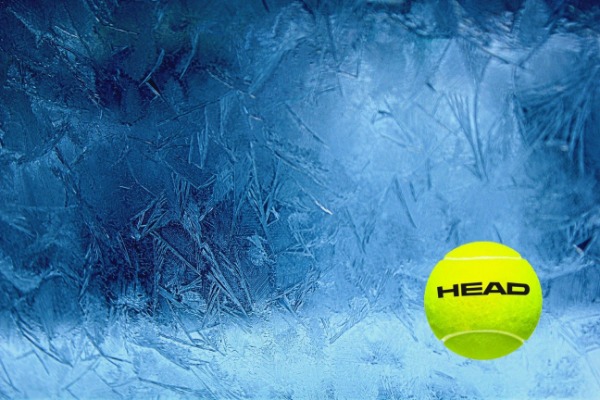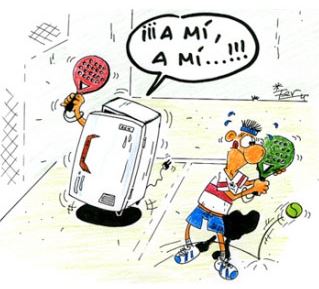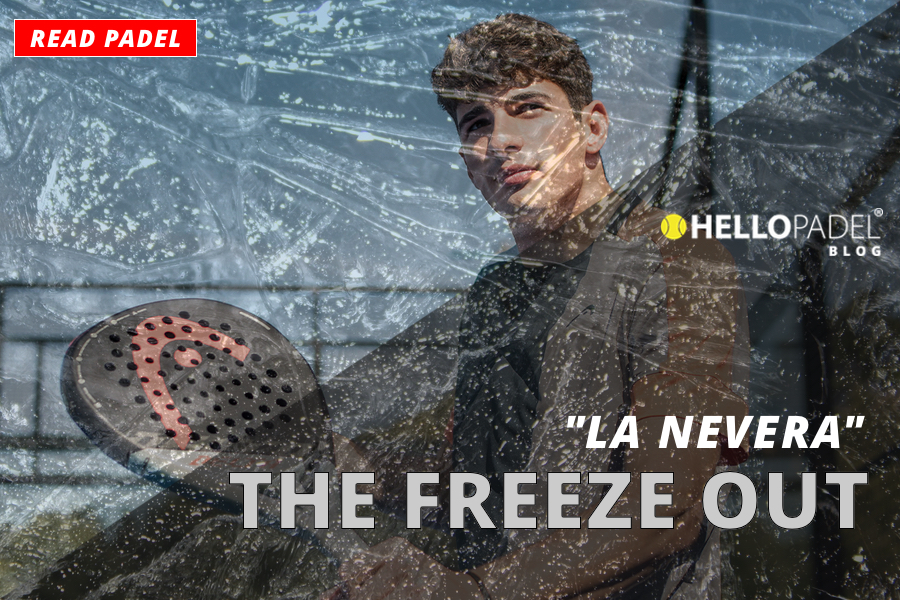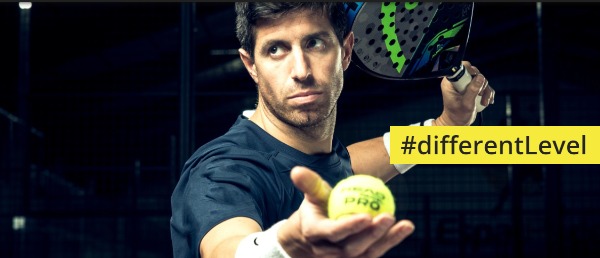Introduction
Freeze out – As with other sports, padel also uses its own slang.
Within the padel vocabulary we can find words that, logically, do not refer to their original meaning. Words like “la víbora“, “la dormilona“, “la bandeja“… are words that everyone knows, but perhaps not everyone knows exactly what they refer to when we use them in padel.
In this article we are going to talk about one of these words or expressions that padel uses: “hacer la nevera” which means to ”freeze out a player”
What does it consist of to freeze out a player?
When in padel we say “freeze a player out”, we are referring to putting the majority of the game on the lesser player or the one who is making more mistakes..
When this happens, the player who receives very few balls, may lose interest in the match, become demoralised and end up “cooling down”, hence the expression.


The “freeze out”, therefore, is suffered (if we do it ourselves) by the opponent we consider to be the better player.
As we can see, this concept refers to the implementation of a tactic.
Regarding this ”tactic”, we can find 2 situations:
- We are receiving a “freeze out” (they always play on my partner or they always play on me).
- That we are doing this to one of our opponents.
We could also distinguish between partial “freeze out” (playing most of the balls to one player) or total “freeze out” (hitting all the balls to one player).
Observation
In our opinion, when we play friendly or training matches, we shouldn’t use this tactic, as everybody wants to play or train, have fun, play sport and has also paid for the court and the balls.
What is the purpose of this tactic?
This tactic has a double objective, which will have a different effect depending on which player of the opposing pair we are referring to.
On the one hand, if we refer to the player on whom we load most of the game, we will try to increase the pressure on him by making him bear all our blows and attacks, thus transmitting to him that the match depends on him, confirming that he is the weakest of the pair and wearing him down physically and mentally.
On the other hand, if we refer to the player who barely touches the ball, we will try to take him away from the match, make him lose interest in the match, make him desperate, make him anxious about touching the ball at all costs, leave him inactive so that he cools down, rushes or worsens his game.
Pros and cons of the freeze out for the player who receives all the balls:
Advantages:
- He knows in advance that he must be very alert at all times as they will almost certainly hit the ball to him.
- Continuity of play on him can lead to him becoming more and more confident with his shots and eventually playing well.
- In some cases, this situation could trigger his motivation and pride in wanting to win the match at all cost.
Disadvantages:
- Physical fitness may be impaired by having to endure so much volume of play.
- May cause an increase in the pressure he feels, both from the situation and from his own partner.
- It can affect his mood because he clearly sees that he is the “worst” of the pair.
Tips for when we are receiving the freeze out:
Remember that receiving a freeze out in competition is something very common and normal.
Although it may seem obvious, it is very important to remember that receiving a freeze out is not something personal. Facing the freeze out with this in mind will allow us to face it in a much calmer, serene and effective way.
Analyse how the game is going.
If we are receiving a freeze out, but our partner is in good physical condition and we are winning, we should continue the same. What works, don’t change it.
Talk to your partner and decide on a tactic.
Communication and rapport with your partner are essential.
Our partner may be getting all the balls, but he may not perceive it that way. Or our partner may believe that continuing to receive all the balls is the best thing for the game.
When faced with a freeze out, talk to your partner, analyse the situation and come up with a plan. If the plan doesn’t work, change it and look for another one.
Try to stay connected to the point and to the match.
We have to try to stay in the match and in each point and not lose concentration and motivation even if we are not receiving any balls. It can help to always keep your partner informed during the point about what your opponents are doing.
If we get out of the game, it is likely that when we touch a ball, we will miss it because we are not concentrating on the point.
Keep calm.
A player who doesn’t touch a single ball can easily become impatient and exasperated. This can cause him to play fast and want to touch the ball any way he can to try to win the point without analysing if he was in a favourable condition to try to do so. This would lead him to push his strokes to the maximum, making, logically, many mistakes and losing his confidence.
Always stay active.
This means always moving and waiting to try to intercept the opponent’s ball. Show your opponents that you are there, that if they execute the shot well, you will go in for the ball. In this way, you will also be helping your partner to cover less space and forcing opponents to make a mistake by to risking their shots more so that you don’t catch them.
Demonstrate a positive attitude.
Even if we feel it, we should never show our opponents negative emotions such as despair, apathy, boredom, anxiety, etc. This would be confirming to them that your tactic is working.
Support your teammate.
It is essential to encourage and reassure the partner who is receiving all the balls so that they can cope as well as possible with this situation and all that it entails.
Avoid making comments such as: “don’t worry, leave it to me, I’ll take care of everything”, “leave all those balls to me, I’ll take care of the game”… Instead of this type of comment, you should make supportive comments and give them specific instructions to counteract the freeze out (next point).


How to try to counteract “the freeze out”.
Have the partner play parallel.
Playing cross-court balls is always easier and safer as we have more distance in front of us and the net is a little lower.
Therefore, if our partner is the one who is receiving all the balls, he/she should try to hit, when possible as it involves more risk, more balls in parallel in order to force or facilitate the opponent to play crosscourt.
Play further back than your partner.
If our partner is positioned at the net and we stay behind, in general, there will be a much greater chance that the opponents will hit the ball to us, as from the volley we can do much more damage.
If they still continue to play on our partner, at least, if they are at the net, they can be more aggressive and put more pressure on the opponents, making it more difficult for them to control their shots. And if they hit a lob and pass it over the top, we can go for that ball and get into the point.
Play more damaging shots.
If our balls are easy and do not generate any damage, it will be very easy for our opponents to direct the ball at our weaker partner. That is why, as far as possible, we must try to put them under pressure, to make it difficult for them to return our balls. Thus, their priority will be to try to return the ball and not to play it on our partner.
Have the best player play on the side of your backhand.
In this way, it is much easier for him to take the balls that go down the middle and have the chance to hit good shots because he has his forehand and backhand on the good side.
Do not play Australian style.
The fact of always playing on the same side makes it easier for our opponents to direct the ball to the weakest player, because he is always in the same place. On the other hand, if when we serve we change sides at each point, we force our opponents to change direction of their shots, and this will mean that they will not always be as effective at directing the ball.
Even during the same point, if there is the possibility of doing so because we have been passed over with a lob, it is good to change sides with our partner.
We should also do the freeze out to them.
If, despite applying all the above points, they continue to freeze us out, we can also freeze them out. Whenever possible, it is best to do it to the player in front of the player who is not receiving a ball.
Tips on how to execute a good freeze out.
- 80%-20% or 70%-30% ratio.
Many coaches agree that doing a total freeze out is not the best thing to do.
If we hit all the balls to one player or increase this proportion, in many cases, this player will end up playing much better because he has a lot of rythm, so the freeze out will no longer be as effective.
Also, if we always hit the ball to the same player, the opponents already know where we are going to play and we will lose the uncertainty factor.
- Play the easy balls to the better player.
- When under pressure, Play the difficult balls to the lesser opponent.
- If the freeze out is giving us good results, keep doing it, don’t change it.
Conclusion:
Doing the freeze out is a very common and widely used tactic in padel, especially in amateur padel.
However, executing it successfully is not always an easy task. To perform it effectively it is necessary to have the appropriate technical resources, master the direction of the ball at all times, have good communication with your partner and follow the same execution plan.
Although we have seen that there are some guidelines and tips that can help us to avoid or counteract when we are being frozen out, the most effective way to avoid it is that both players of the pairing have the same level. The greater the difference in level between the two players, the more likely it is that we will be frozen out.
MORE PADEL TIPS: HERE
REEAD MORE ON PADEL: HERE
 Upgrade now
Upgrade now





